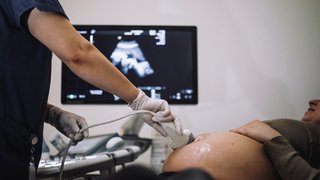Is giving birth to twins genetic? Well, that depends
October 8, 2024

If you’ve recently learned you are having twins, you’ve got a lot on your mind. Along with the thrills and moments of feeling overwhelmed, one question is likely to come up from friends and coworkers: Does having twins run in your family?
The answer is not usually a clear “yes” or “no.”
Having identical twins does not run in families. For identical (monozygotic) twin pregnancies, a single egg is fertilized by a single sperm. During early development, the embryo splits in two – the babies have the same DNA. Anyone has a chance of having identical twins, because the splitting embryo is spontaneous and not linked to genetics.
That said, having fraternal twins can be genetic. With fraternal (dizygotic) twin pregnancies, two eggs are released by the ovaries at the same time and are fertilized by separate sperm. When more than one egg matures and is released by the ovaries in a particular month, it is called hyperovulation.
Hyperovulation is influenced by both genetic and non-genetic factors. Research has identified specific genes on chromosomes 1, 11, and 15 that are associated with an increased likelihood of fraternal twins, and there may be other genetic factors involved. Fraternal twins can be boys, girls, or one of each, and each baby has unique DNA. You can think of fraternal twins as siblings who just happen to share the same womb. The likelihood of having fraternal twins is also influenced by:
- Age: Higher rate of twins with increasing maternal age.
- Previous twin pregnancy: Increases the likelihood of a subsequent twin pregnancy by five times.
- Ancestry: In some African populations, the incidence of fraternal twin pregnancies is as high as 1 in 20.
Twins account for 31.2 per 1,000 live births, according to the Centers for Disease Control and Prevention (CDC). Identical twins are rare, occurring in only three or four per 1,000 births. While genetic testing can’t tell you the odds that you will have twins, it can identify characteristics in twin pregnancies that can help guide mother-baby care.
As genetic counselors within the UT Southwestern Ob/Gyn team, we have the honor of working with many families each year that are expecting twins. Here are answers to some of our patients’ most-asked questions and how genetic testing can help inform your twin pregnancy care.
Can genetic testing tell me if my twins are identical?
Non-invasive prenatal testing (NIPT), available for all pregnant patients, screens for certain common chromosomal disorders, such as Down syndrome and Edwards syndrome (also known as trisomy 18). Depending on which lab performs the NIPT, it can also determine whether your twins are fraternal or identical.
During pregnancy, small fragments of your babies’ DNA enter your bloodstream. NIPT can detect whether there are one or two extra DNA signatures besides your own:
- Two DNA signatures means identical twins.
- Three means fraternal twins.
Genetic testing is optional in any pregnancy. You can talk with your prenatal care provider if you are interested in NIPT.
Does having twins skip a generation?

Skipping a generation can happen in some cases, depending on whether the twins are boys or girls. Fraternal twin pregnancies are a result of hyperovulation of the mother – the father’s sperm does not decrease or increase the chance of having twins.
So, if a generation of children are mostly boys, it may seem like instances of twins “skip” a generation if their female partners don’t have the traits that lead to hyperovulation. If the next generation has more daughters, however, the chances of another round of twins rise again, particularly for families with gene variations that increase the odds.
Related reading: What to expect when you’re expecting twins – or more
Does IVF increase my chances of twins?
Having in vitro fertilization (IVF) does increase the chance of twins. In IVF, eggs are removed from the ovaries and fertilized with sperm in a laboratory. A resulting embryo is then implanted in the uterus. If more than one embryo is transferred into the uterus and multiple embryos are successfully implanted, then the pregnancy could result in fraternal twins. IVF has also been shown to be associated with an increased chance of identical twins, even when only one embryo is transferred into the uterus. Non-IVF fertility treatments that induce ovulation are significantly more likely to lead to twins or even higher-order multiples.
The increased chance of twin pregnancy is not genetic in these cases. Over the last four decades, incidence of twin pregnancies has nearly doubled. The increase in IVF pregnancies and pregnancies conceived with the assistance of other assistive reproductive technologies has likely impacted this trend.
How will my care change if I’m having twins?

Twin pregnancies are considered high-risk. Mothers expecting multiples should work with a maternal-fetal medicine doctor to navigate the increased chance for certain complications, such as:
- Preterm birth. (About 60% of twins are born before 37 weeks, so these conversations are crucial).
- Lower birth weight.
- Need for hospitalization during pregnancy.
- Miscarriage.
Related reading: Celebrating Mother’s Day with two sets of twins: Christine’s story
"Every pregnancy has a small chance of twins, and a family history can elevate those odds."
Heather Fisher, M.S.
- Preeclampsia, or high blood pressure during pregnancy. Your physician will discuss if low-dose aspirin is appropriate for you to reduce risk.
- Gestational diabetes.
- Cesarean delivery.
- Additional bleeding during delivery.
As soon as a twin pregnancy is confirmed, your health care provider will do a first-trimester ultrasound to determine whether the twins share a placenta or amniotic sac:
- Monochorionic twins share a placenta.
- Dichorionic twins each have their own placenta.
- Monoamniotic twins share an amniotic sac.
- Diamniotic twins have their own amniotic sacs.
Sharing a placenta or amniotic sac further increases the risk of complications such as preterm birth, selective fetal growth restriction, and twin-twin transfusion syndrome, a condition in which blood flow between the twins is unbalanced, leading to one baby getting too little blood. Sharing a sac significantly increases the risk of miscarriage due to cord entanglement, and all of these pregnancies are offered hospitalization and late preterm delivery to reduce this risk in the third trimester.
You’ll have more frequent checkups to assess your health and the babies’ development. As your due date comes closer, your doctor may recommend induction or a planned C-section.
Every pregnancy has a small chance of twins, and a family history can elevate those odds. Just like with single babies, genetic testing can give you information about your babies’ risk of chromosomal disorders and allow for proactive prenatal care.
To discuss genetic testing during pregnancy, call 214-645-8300 or request an appointment online.












